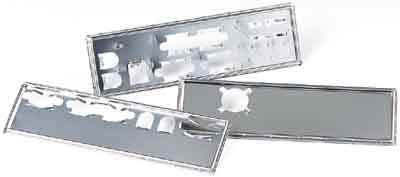[ The PC Guide | Systems and Components Reference Guide | System Case | Parts of the System Case ]
I/O Connector Port Holes or I/O Template(s)
Your PC would not be of much use unless you could interact with it, and to do that you need to be able to connect to the main PC box your I/O peripherals, such as your keyboard, mouse, printer and so on. The cables from these devices actually connect to the motherboard, and therefore holes are provided in the case to permit access to the ports that attach to the motherboard (either by direct mounting, or via internal cables from ports mounted to the case). There are two different ways that this is done, depending primarily on the form factor (and thus the age) of the system.
On older XT, AT, Baby AT and LPX cases, there are a number of discrete holes in the case itself, in the shapes necessary to accomodate the round keyboard connector, and "D-shaped" serial and parallel connectors. On XT, AT and Baby AT systems, ports were installed to these holes, with the connector facing out from the hole, and cables running from the inside of the port to the motherboard. Since some systems included more parallel ports than others, since some serial ports were 9-pin and others 25-pin, and since it was desirable to leave room for expansion, many of these older cases included more holes in the case than some motherboards required. Therefore, to keep out dirt and ensure proper air circulation in the case, most manufacturers covered unused I/O port holes. Some cases had discrete port covers that screwed in place, while other case makers just manufactured the back panel of the case with sheet metal punchouts where the ports would go, and the installer would remove the appropriate ones. On LPX systems the holes were placed to line up with one of the standard configurations of I/O ports installed directly to the LPX motherboard, instead of mounting ports to the case itself.
|
Closeup of I/O port holes (one keyboard, two 9-pin
serial, |
Original image � Kamco Services |
Newer form factors, including ATX (and its variants), NLX, and WTX, specify that the I/O ports be mounted directly onto the motherboard in either a single or double row. A wide variety of configurations is possible, to provide motherboard manufacturers the flexibility to design solutions for various PC requirements. To accomodate this flexibility, cases designed for these form factors did away with the rigidly-placed I/O port holes in favor of interchangeable plates with different configurations and patterns of holes. These removable metal plates are called I/O templates, or sometimes, I/O shields. Often, a case will come with templates that correspond to one or more of the most popular motherboard designs used with that case, but these may not match up well with every motherboard. You may need to get a suitable replacement template from your motherboard manufacturer.
|
A set of ATX I/O templates showing hole patterns
corresponding to |
Image � PC Power & Cooling, Inc. |
![]() Next: Power Supply and Accessories
Next: Power Supply and Accessories
| The PC Guide
(http://www.PCGuide.com) Site Version: 2.2.0 - Version Date: April 17, 2001 © Copyright 1997-2004 Charles M. Kozierok. All Rights Reserved. |
Not responsible for any loss resulting from the use of this site. Please read the Site Guide before using this material. |

